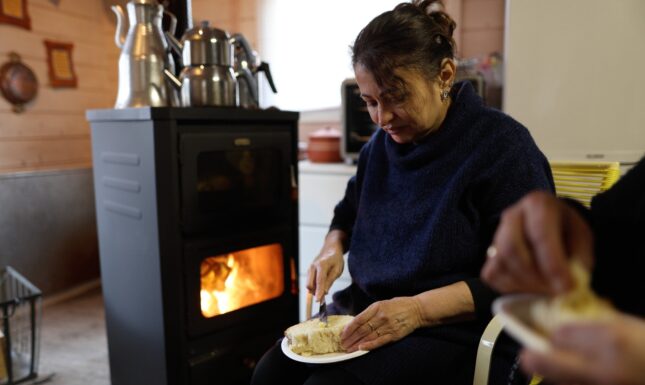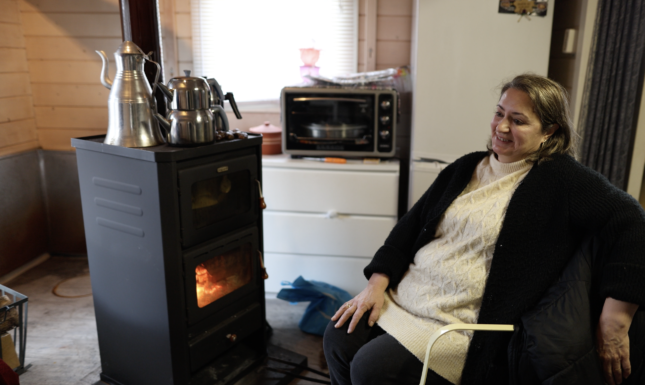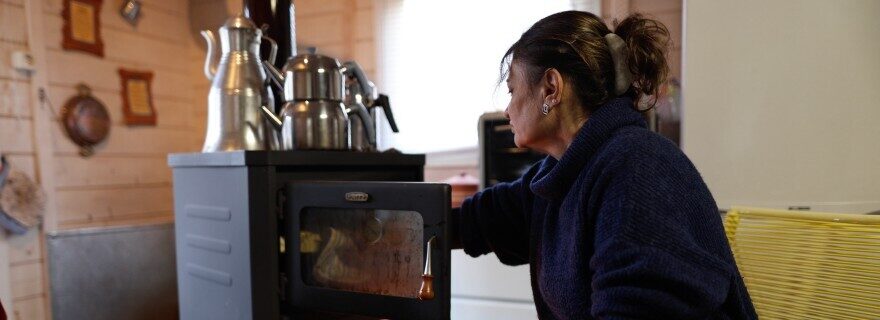The Kuzine: How a Turkish Stove Makes a Home
In Turkish-Dutch allotment gardens, gardeners, family and friends gather around the kuzine. The stove forms the centerpiece of gatherings, but is also central in the intricate relationship between sensory experiences, passage of time, and emotional reminiscence. How does a Turkish stove make a home in the garden?
Huriye’s garden
It is a rainy afternoon and my aunt Huriye and her family find themselves within the confines of a small cabin at an allotment garden. It is located amidst greenery and desolated sports fields in the periphery of a small town called Gorinchem. Inside, the kuzine holds a central place and everyone is curled up in a comfortable nook around a small table. Next to the teapot, there is a large jug of water on top of the kuzine, kept warm until needed. To the left, firewood is stacked, ready to fuel the fire that provides not only heat, but also the means to cook drinks and meals such as ''mayali ekmek'', "çarşaf böreği", ''keşkek'' and ''katmer''. During weekends like these, the cabin becomes a central meeting point for friends and family in order to relax and enjoy traditional dishes. The abundance of food covers every inch of the table, showing both the generosity of the host and all of the collective efforts. As the aroma fills up the room, everyone eagerly checks the kuzine to see if the food is ready. While the rain trickles down the cottage's roof, the smoke from the kuzine-chimney finds its way out through the long pipe that is connected to the ceiling.
Huriye sits in front of the kuzine and expresses how the whole setting in the cabin feels just like the köy (the birth village). As she sips her tea slowly, she experiences a flood of childhood memories and with a subtle smile she says: ''It feels like I just finished playing outside and it is time to go home for dinner''. Within the garden cabin, Turkish-Dutch gardeners like Huriye actively engage in rituals and traditions, recreating customs and routines reminiscent of their childhood and early way of life. The space of the cabin is thoughtfully adorned and it becomes a place that can evoke physical sensations, emotions, memories and nostalgia simultaneously.

Sensory experiences and memories
The kuzine in particular takes a central role in the practices of active and passive reminiscing of the past. Stories told while gathered around the stove show how deep-seated memories and sensations can materialize across space and time. However, the evoked nostalgia is not an intrinsic property of objects, but ''a result of an interaction between subjects and objects, between actual landscapes and the landscapes of the mind''. In settings like Huriye's garden cabin, the shared acts and memories weave into a collective narrative that transcends personal recollections. It is characterized by a longing, based on a more introspective and thoughtful engagement with the past. It is not about the recovery of a certain truth or situation, but about accepting the temporality of life.
The rituals and nostalgic journeys, along with the unconventional use of cabins and stoves on the allotment during winter time, are common trends among Turkish-Dutch gardeners – as colleague Simay Çetin and I observed during fieldwork. The sentimentality of such activities are further underscored by the playful remarks by interlocutors, who jokingly note: "It seems to be only us 'buitenlanders' who genuinely enjoy coming here during winter''.
Allotments provide a chance for marginalized groups or individuals to engage in collective endeavors, which contributes to a sense of identity and community, social inclusion, personal growth and accordingly ''they can help to shape lives and encourage social integration''. This gives individuals like Huriye and her compatriots the opportunity to negotiate their identities and to foster a sense of belonging.
Heritage and critical nostalgia
Nostalgia for a rural life likely influences Huriye's love for gardening or wanting to pass on certain ideas, memories, rituals or objects. The nostalgia she experiences most certainly informs how she engages with her heritage. This raises questions about how individuals generate their heritage, what they choose to preserve and what they creatively adapt or transmit to future generations. Thinking of heritage as a ''a creative engagement with the past in the present'' gives us the opportunity to shape our futures with an active and informed role. On the other hand, it is imperative to consider that ''forgetting is a necessary form of cultural production''.
In one of my recent recordings, Huriye is fondly recalling her childhood experiences of accompanying her mother to work in the fields between cherry trees and vineyards. She is reminiscing about their ''paradise'' with beautiful waterfalls where she used to play. Behind the nostalgic, idyllic and sentimental recollections, also lies a narrative of hard physical labor. While Huriye enjoyed her time as a child, her mother – my grandmother – bore the weight of managing the household and the land alone for seven years while my grandfather worked abroad in the Netherlands as a guest laborer. This highlights the complexity and nuances inherent in nostalgia and the generation of heritage.

Conclusion
The kuzine not only facilitates social interactions and culinary traditions but also enriches sensory experiences, serving as a medium for evoking memories and fostering social and emotional connections within Turkish-Dutch allotment gardens. By recreating the ambiance of the birth village within the cabin, conscious effort is made to preserve and relive cherished moments, enriching the present with the essence of the past, navigating through complex feelings of loss, nostalgia and homemaking. The deep emotional connection to the kuzine in relation to individual narratives, highlights its significance as a symbol of home, cultural continuity, and the passing down of heritage within the allotment environment. From baking pastries to roasting chestnuts, the kuzine, versatile as it is, seems essential in Turkish-Dutch allotment gardens.
The results from this research stem from collaborative efforts with my colleague Simay Çetin as part of the project 'At Home Otherwise'. In this project we undertake field trips to allotment gardens and explore ideas such as homemaking and democratization of heritage.


0 Comments
Add a comment